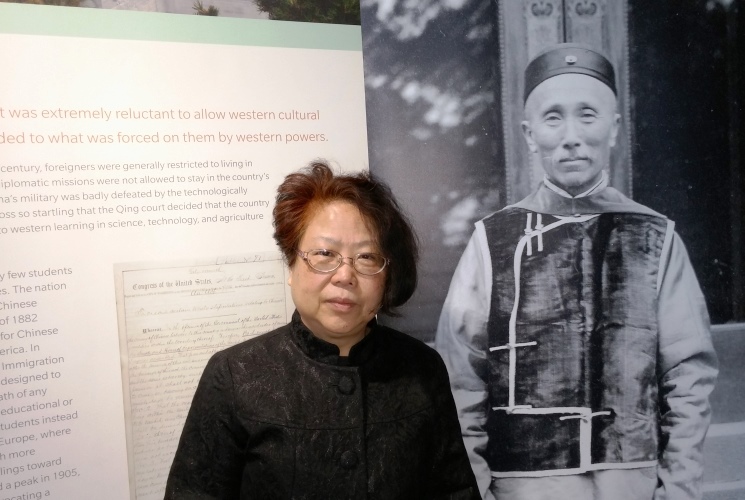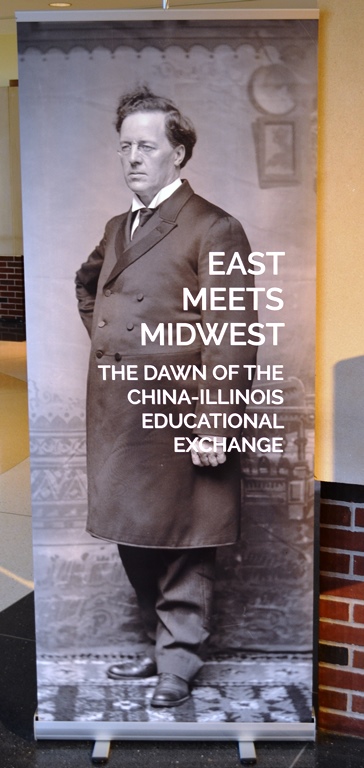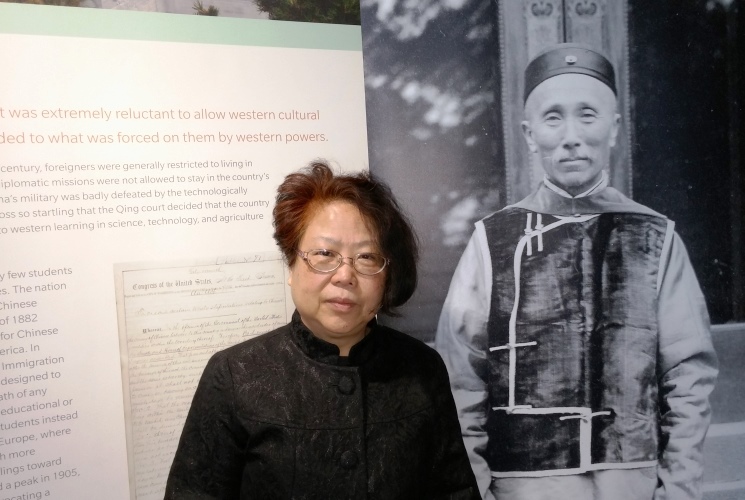Alumna's dissertation influential in creation of China-Illinois museum exhibit
by Sal Nudo / Feb 25, 2015

 At the start of the 21st century, Carol Huang, Ph.D. ’01 EPOL, wrote a dissertation called The Soft Power of U.S. Education and the Formation of a Chinese American Intellectual Community in Urbana-Champaign, 1905-1954. Years later, her publication helped spark an exhibit at the Spurlock Museum in Urbana called East Meets Midwest: The Dawn of the China-Illinois Educational Exchange.
At the start of the 21st century, Carol Huang, Ph.D. ’01 EPOL, wrote a dissertation called The Soft Power of U.S. Education and the Formation of a Chinese American Intellectual Community in Urbana-Champaign, 1905-1954. Years later, her publication helped spark an exhibit at the Spurlock Museum in Urbana called East Meets Midwest: The Dawn of the China-Illinois Educational Exchange.
The East Meets Midwest exhibit within the Hundley Central Core Gallery of the Spurlock tells the story—through six hanging panels, nine donated artifacts, and detailed content—of the beginnings of the close and enduring relationship between the University of Illinois at Urbana-Champaign and China. The country and school have a historic collaboration that remains strong today, but the exhibit focuses specifically on the years 1904-1920, during the tenure of UI President Edmund James.
“People like origin stories,” said co-curator and museum director Wayne Pitard, “and this is the origin story for the reason why there are more Chinese students here than any foreign groups of students at the University. That’s been the case since at least 1910.”
Pitard called James “one of the leading educators in the argument for Chinese educational exchange.” During his era, the federal Chinese Exclusion Act of 1882 made it extremely difficult for Chinese laborers and average citizens to come to the U.S. President James sought to reverse that mentality in his country, writing an influential memorandum to President Theodore Roosevelt and establishing a relationship with Chinese minister Wu Tingfang to foster a connection between his campus and the Middle Kingdom.
“Edmund James is the individual most responsible for transforming the University of Illinois from a second-tier university to a world-class university,” Pitard said, noting the large increase in campus buildings, faculty members, and students during the president’s tenure, as well as other significant accomplishments.
Until 1960, Illinois graduated the highest number of Chinese doctorate students in the U.S., an accomplishment that can be traced back to the outreach efforts of the University’s fourth president.
James’s relationship with Chinese officials resulted in several groundbreaking occurrences, which included securing the housing for Chinese students on campus. Eventually, young Chinese men and women began to make their way to the University.
An on-campus observation
 Back when she first started her doctorate research while raising two young children, Huang said she wondered why there were so many Chinese people on Illinois’ campus. With Dr. James Anderson as her adviser, she delved into the UI Archives to see if she could decipher why.
Back when she first started her doctorate research while raising two young children, Huang said she wondered why there were so many Chinese people on Illinois’ campus. With Dr. James Anderson as her adviser, she delved into the UI Archives to see if she could decipher why.
“Once I dove into it I found this brilliant history, local history, but it was so global in many ways. I was fascinated by it,” Huang said.
Her research eventually led to what would become a powerful dissertation; one chapter, in fact, received an international award in 2001. More recently, Pitard said the publication helped solidify the work that he and Huang, along with co-curator Yu (Ian) Wang, utilized to complete the East meets Midwest exhibit.
“The three of us just sort of plunged into searching for things in archives and in other places. We made quite a number of discoveries,” Pitard said.
One such discovery, found by Huang, was learning the whereabouts of the grandson of the University’s first Ph.D. recipient, Wang Chinghun. The grandson turned out to be Huang’s longtime friend Rockwell Chin, who is the director of the Office of Equal Opportunity and Diversity at the New York State Office of Human Rights.
Pitard said East Meets Midwest is the first smaller-sized exhibit at Spurlock Museum to be located in the Hundley Central Core Gallery, a space viewable from the well-used lobby. The metaphorical meaning of the exhibit’s placement, according to Huang, is that students begin a significant journey when they start their coursework at Illinois. After graduating from this educational genesis, they move outward into the world. When they move beyond East Meets Midwest within the museum, students can discover other geographic areas that include artifacts and information from North and South American, Classical, Asian, European, African, and Ancient Near Eastern cultures.
Now a professor at The City College of New York, Huang is reworking her dissertation and eventually publishing it as a book. She is appreciative of the guidance that Anderson and Professor Bill Trent provided her while at the College, and she recognized current UI President Robert Easter as a true friend of China. The Illinois-China connection remains strong in her view and has had lasting effects.
“The U of I was able to build a reputation and get a lot of Chinese students who wanted to study in the United States,” she said. “That produced many distinguished Chinese scholars and industry entrepreneurs.”
If you enjoyed this story and want to learn how Education students now visit China and other countries on a regular basis, discover the College’s study abroad and student exchange programs.